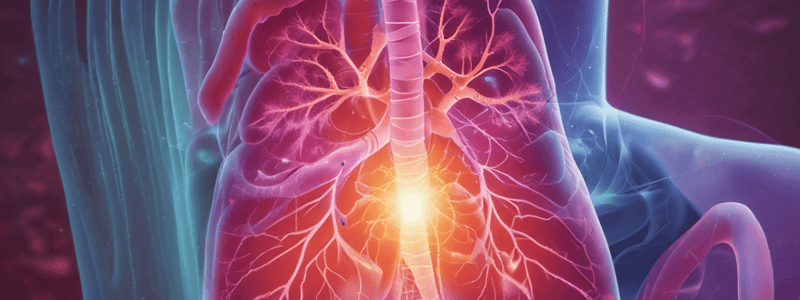Podcast
Questions and Answers
Which of the following findings is most characteristic of a tension pneumothorax?
Which of the following findings is most characteristic of a tension pneumothorax?
- Decreased respiratory expansion on the affected side
- Decreased chest wall movement on the affected side
- Decreased tactile fremitus
- Tracheal shift to the contralateral side (correct)
Which of the following lung diseases is most likely to cause asymmetrical chest wall movement during respiration?
Which of the following lung diseases is most likely to cause asymmetrical chest wall movement during respiration?
- Emphysema
- Chronic bronchitis
- Asthma
- Pleural effusion (correct)
What is the expected normal range for respiratory expansion during palpation?
What is the expected normal range for respiratory expansion during palpation?
- 2-5 inches (correct)
- 5-10 inches
- 0-2 inches
- 10-15 inches
Which of the following lung diseases is most likely to cause decreased tactile fremitus?
Which of the following lung diseases is most likely to cause decreased tactile fremitus?
Which of the following lung diseases is most likely to cause increased tactile fremitus?
Which of the following lung diseases is most likely to cause increased tactile fremitus?
What is the primary cause of tracheal shift in a tension pneumothorax?
What is the primary cause of tracheal shift in a tension pneumothorax?
In a patient with pneumothorax, which of the following would you expect to find on auscultation?
In a patient with pneumothorax, which of the following would you expect to find on auscultation?
A patient presents with a barrel chest, respiratory distress, and a mucousy cough. Which condition would you suspect?
A patient presents with a barrel chest, respiratory distress, and a mucousy cough. Which condition would you suspect?
In a patient with a pleural effusion, which of the following would you expect to find on percussion?
In a patient with a pleural effusion, which of the following would you expect to find on percussion?
Which of the following adventitious breath sounds is associated with the rattling of secretions in the large airways?
Which of the following adventitious breath sounds is associated with the rattling of secretions in the large airways?
In a patient with emphysema, which of the following would you expect to find on inspection?
In a patient with emphysema, which of the following would you expect to find on inspection?
Which of the following adventitious breath sounds is associated with an acute exacerbation of asthma?
Which of the following adventitious breath sounds is associated with an acute exacerbation of asthma?
Which of the following conditions is MOST likely to cause decreased diaphragmatic excursion?
Which of the following conditions is MOST likely to cause decreased diaphragmatic excursion?
During auscultation, which type of breath sound would be indicative of narrowed smaller airways, as seen in conditions like asthma or COPD?
During auscultation, which type of breath sound would be indicative of narrowed smaller airways, as seen in conditions like asthma or COPD?
A patient presents with stridor, which is described as a wheeze that is predominantly inspiratory. Which of the following conditions is MOST likely to cause this finding?
A patient presents with stridor, which is described as a wheeze that is predominantly inspiratory. Which of the following conditions is MOST likely to cause this finding?
During percussion, the patient's diaphragmatic excursion is found to be decreased. Which of the following is the MOST likely cause of this finding?
During percussion, the patient's diaphragmatic excursion is found to be decreased. Which of the following is the MOST likely cause of this finding?
A patient with a history of COPD presents with wheezing and shortness of breath. Which of the following is the MOST appropriate next step in management?
A patient with a history of COPD presents with wheezing and shortness of breath. Which of the following is the MOST appropriate next step in management?
During auscultation, a patient is found to have decreased breath sounds in the left lower lung field. Which of the following is the MOST likely cause of this finding?
During auscultation, a patient is found to have decreased breath sounds in the left lower lung field. Which of the following is the MOST likely cause of this finding?
Which of the following conditions would cause the trachea to deviate away from the affected side?
Which of the following conditions would cause the trachea to deviate away from the affected side?
In a patient with chronic obstructive pulmonary disease (COPD), which of the following findings would you expect on inspection of the thorax?
In a patient with chronic obstructive pulmonary disease (COPD), which of the following findings would you expect on inspection of the thorax?
Which of the following conditions is associated with cyanosis and clubbing of the fingers?
Which of the following conditions is associated with cyanosis and clubbing of the fingers?
In a patient with a large left-sided pleural effusion, which of the following findings would you expect on inspection of the thorax?
In a patient with a large left-sided pleural effusion, which of the following findings would you expect on inspection of the thorax?
Which of the following conditions is associated with a decreased anteroposterior (A-P) diameter of the thorax?
Which of the following conditions is associated with a decreased anteroposterior (A-P) diameter of the thorax?
Which of the following signs would you expect to see in a patient with a right-sided tension pneumothorax?
Which of the following signs would you expect to see in a patient with a right-sided tension pneumothorax?
Which of the following conditions is associated with decreased tactile fremitus?
Which of the following conditions is associated with decreased tactile fremitus?
A patient with a history of chronic smoking presents with shortness of breath and wheezing. Which of the following lung diseases is the most likely diagnosis?
A patient with a history of chronic smoking presents with shortness of breath and wheezing. Which of the following lung diseases is the most likely diagnosis?
During percussion of the lungs, which of the following would indicate the presence of a pleural effusion?
During percussion of the lungs, which of the following would indicate the presence of a pleural effusion?
A patient with a history of asthma presents with acute shortness of breath and wheezing. Which of the following is the most appropriate initial treatment?
A patient with a history of asthma presents with acute shortness of breath and wheezing. Which of the following is the most appropriate initial treatment?
Which of the following lung diseases is associated with increased tactile fremitus?
Which of the following lung diseases is associated with increased tactile fremitus?
A patient with a history of chronic bronchitis presents with increased sputum production and wheezing. Which of the following is the most likely cause of these symptoms?
A patient with a history of chronic bronchitis presents with increased sputum production and wheezing. Which of the following is the most likely cause of these symptoms?
Which of the following is the most appropriate technique for assessing diaphragmatic excursion during a physical examination?
Which of the following is the most appropriate technique for assessing diaphragmatic excursion during a physical examination?
A patient with a history of trauma presents with sudden-onset shortness of breath and chest pain. Which of the following is the most likely diagnosis?
A patient with a history of trauma presents with sudden-onset shortness of breath and chest pain. Which of the following is the most likely diagnosis?
Which of the following lung diseases is associated with decreased diaphragmatic excursion?
Which of the following lung diseases is associated with decreased diaphragmatic excursion?
A patient with a history of chronic obstructive pulmonary disease (COPD) presents with increased shortness of breath and wheezing. Which of the following is the most appropriate initial treatment?
A patient with a history of chronic obstructive pulmonary disease (COPD) presents with increased shortness of breath and wheezing. Which of the following is the most appropriate initial treatment?
Which of the following is a characteristic sign of a pneumothorax?
Which of the following is a characteristic sign of a pneumothorax?
A patient with asthma is most likely to exhibit which of the following breathing patterns?
A patient with asthma is most likely to exhibit which of the following breathing patterns?
A patient with a pleural effusion would most likely exhibit which of the following physical exam findings?
A patient with a pleural effusion would most likely exhibit which of the following physical exam findings?
Which of the following is a characteristic symptom of chronic bronchitis?
Which of the following is a characteristic symptom of chronic bronchitis?
A patient with emphysema is most likely to exhibit which of the following physical exam findings?
A patient with emphysema is most likely to exhibit which of the following physical exam findings?
Which of the following is a characteristic feature of clubbing of the fingernails?
Which of the following is a characteristic feature of clubbing of the fingernails?
In a patient with pectus carinatum, what would you expect to find on inspection of the thorax?
In a patient with pectus carinatum, what would you expect to find on inspection of the thorax?
In a patient with pectus excavatum, what would you expect to find on inspection of the thorax?
In a patient with pectus excavatum, what would you expect to find on inspection of the thorax?
In a patient with a tension pneumothorax, which of the following would you expect to find on inspection of the thorax?
In a patient with a tension pneumothorax, which of the following would you expect to find on inspection of the thorax?
In a patient with a large left-sided pleural effusion, which of the following would you expect to find on inspection of the thorax?
In a patient with a large left-sided pleural effusion, which of the following would you expect to find on inspection of the thorax?
In a patient with emphysema, what would you expect to find on inspection of the thorax?
In a patient with emphysema, what would you expect to find on inspection of the thorax?
In a patient with atelectasis (collapsed lung), which of the following would you expect to find on inspection of the thorax?
In a patient with atelectasis (collapsed lung), which of the following would you expect to find on inspection of the thorax?
In a patient with a right-sided lung agenesis (absence of a lung), which of the following would you expect to find on inspection of the thorax?
In a patient with a right-sided lung agenesis (absence of a lung), which of the following would you expect to find on inspection of the thorax?
In a patient with a large right-sided pleural effusion, which of the following would you expect to find on inspection of the thorax?
In a patient with a large right-sided pleural effusion, which of the following would you expect to find on inspection of the thorax?
In a patient with pleural fibrosis (scarring of the pleural lining), which of the following would you expect to find on inspection of the thorax?
In a patient with pleural fibrosis (scarring of the pleural lining), which of the following would you expect to find on inspection of the thorax?
In a patient with a pneumonectomy (surgical removal of a lung), which of the following would you expect to find on inspection of the thorax?
In a patient with a pneumonectomy (surgical removal of a lung), which of the following would you expect to find on inspection of the thorax?




